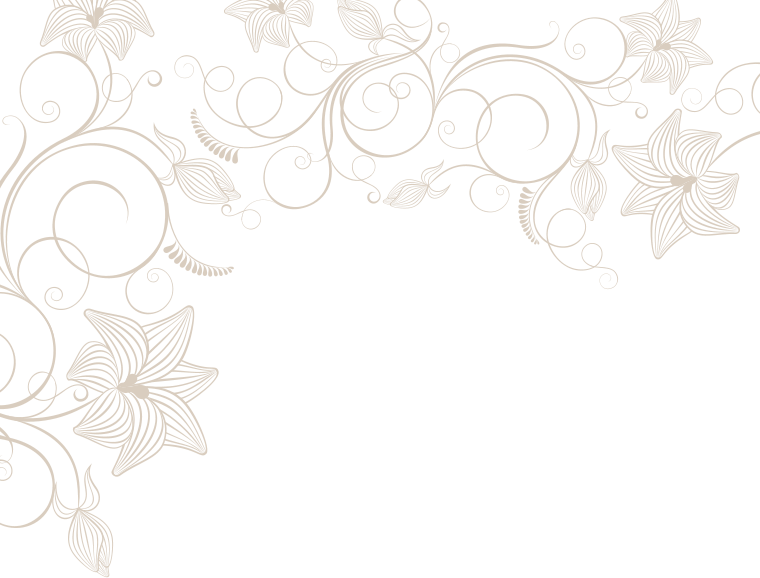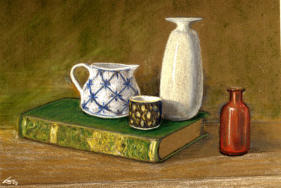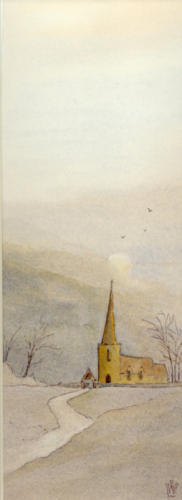




Media
This page lists some of the art media I have used in the past, a little about them, and how they differ. On the mobile phone version of this site, no images are included on this page to allow for the reduced space. To see the full range of images, please use a PC, laptop or tablet with a larger screen
PASTELS and PASTEL PENCILS
A dry medium usually containing a high proportion of chalk or calcite in some form. Finely ground pigment is mixed with the base material and with some binder. It is then dried into stick form or manufactured into pencils. The colour adheres to the paper or painting surface mainly by friction - the finished picture can easily be damaged by scuffing and needs to be mounted and framed quickly to protect it. Pastel has the huge advantage of being easy to blend and has been used for centuries by portraitists looking for perfect skin tones. A lovely medium. Results are relatively quick and the high level of pigment usually means the finished picture is not a liable to fade in strong light as some other options. Pastel can come in several grades of hardness depending on the amount of binder used in manufacture. Pastel pencils are quite hard but can achieve fine detail Disadvantages : can be messy to use and pictures need care in storing and exhibiting.
COLOURED PENCILS
I include wax pencils and watercolour pencils here. Wax Pencils - often referred to as ‘crayons’ are a drawing rather than painting medium and produce a line or shading of colour. Solvents can be used to mix and blend the colour, but usually depth of colour is achieved by putting down many layers on the paper and blending those layers together. Manufacturers use oils and waxes to hold the pigment in a stick form and subsequently on to the paper. An excellent medium for fur and feather and often the medium of choice for animal commissions. For years I have found most students who have watercolour pencils do not properly understand how best to use them and my watercolour pencil courses have been very popular. However, this is not the place for a tutorial - best look at www.penciltopics.co.uk for more information disadvantages : naturally produces a line rather than an area of colour, so techniques have to be learned to get even colour. Watercolour pencils make a good all round choice.
ACRYLICS
First developed in the 1950’s A medium requiring some ability with a brush. The pigment is mixed by the manufacturer with a plastic resin, often PVA. This produces a paint that bonds readily with most surfaces and when dry produces a permanent layer of colour which is waterproof and usually quite weatherproof. It does not require glazing in a frame and acrylics are frequently used for modern murals. As with all art media, Acrylics have advantages and disadvantages. They handle in a similar way to oils and can be used in thick impasto effects and also thinned down much as watercolour. The binder is usually white, but dries clear when it sets, so colours tend to dry darker and stronger as the white content disappears. Can be painted over with other media such as oils. Disadvantages : sets quickly on a hot day so artists need to use a method to keep the atmosphere around the unused colour moist, to delay drying. If left on a brush it will turn the brush into a stick.
OILS
A medium that has been around for centuries. Usually painted on to canvas but has been applied to wooden panels in the past. The paint pigment is suspended in an oil base ( often linseed ) which can take some time to dry. This extended drying period allows artists a period for blending and manipulation of colour. This is not a medium I have used much as I don’t care for the smell and the extended time for a painting in several layers. However, it is a good medium for beginners with a brush as it allows plenty of time for corrections and changes of mind. Once dry, the picture is usually given a fixing layer of varnish to protect it. Disadvantages : mainly down to drying time and also the need for smelly thinners to clean brushes and thin paint to allow the layers dry more quickly.
Breton Cottage.
Painted on site in about 2 hours.
Soft pastel on Ingres paper




The Old Harbour, Honfleur, Normandy, France
Wax Pencils on paper from my original photo.
Painting took about 120 hours
Picton Castle on a calm sea
Acrylic on primed board
painted in about 10 hours
Still Life with a book
Oil on canvas paper
painted from original scene in about 3 hours

WATERCOLOUR
Regarded by some as the best medium to begin with art, but in fact possibly one of the most difficult mediums to do well. Cost is low. A basic painting outfit for watercolours is affordable, and the transport of the essential equipment is simple. It is the actual handling of the medium that introduces the problems. Watercolours depend for their luminous effect on using the white of the paper to shine through. This requires thin layers of colour, careful mixing and careful application. Some colours are opaque, some are transparent, and some granulate when mixed. Beginners often fall foul of mixing up ‘mud’ with too many pigments in their colour choice. The paper used can also have a major input in the results. When it goes well, the results can be amazing. Watercolourists can produce some superbly detailed botanical studies, and some remarkably gentle and enchanting landscapes. It is a lovely medium and always a challenge. Disadvantages : The thin layers of paint on white paper can mean that colours can be fugitive in strong light and protection is needed to prevent fading. Some knowledge of the different pigments helps to avoid ‘Mud’

PEN & WASH
This is an offshoot of Watercolour, but it incorporates a proportion of drawing with a pen. There is debate over whether it is best to draw with the pen first and then add colour with watercolour, or whether to apply the pen lines over the paint. Has the advantage of speed if done on site with the scene in front of you, but can also be very effective if completed with great care in the studio. Colour can be limited to a virtual monochrome and even just the washed in pen line itself, if the ink is soluble and will react to brush and water. Not a lot of disadvantages - I love it as a medium and have tried it in many ways. Often regarded as ‘just a sketch’ but famous artists have worked in this style with great success.
The Accordian Man, Montmartre, Paris
Pen & Wash on paper
painted from my original photo
in about 3 hours

Dusk Church
Watercolour on paper - about 30 minutes
three colours

OTHER MEDIA
There are a host of other media and combinations of media which can be employed for artwork. This is not the place for an exhaustive review, but the pictures and media listed above are all ones I have used and enjoyed. I hope you enjoy seeing my own ventures into the world of painting and drawing and I encourage you to have a try for yourself Updated Jan 2024
Peter Weatherill
Peter Weatherill 2024
Website made in Xara
NEXT













